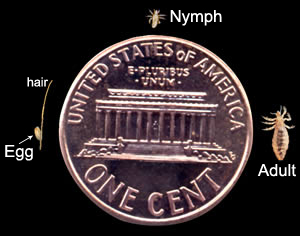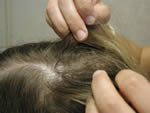by David Moore
Manager of Technical Services and Board Certified Entomologist
with contributions by Eric Smith, PhD, BCE
With school coming back in session, we here at Dodson want you and your family to be aware of what head lice look like, how to help prevent them, and what to do if you discover a child has contracted head lice. If you suspect that someone in your family has head lice, you should report this to a medical doctor who can diagnose this issue. There is very little a pest management professional can do for a true head lice infestation, so contacting a primary physician should be your first priority.
What are head lice?
Head lice are about 1/8” long with a flattened but elongated body with 6 legs and look almost exactly like body lice. However, head lice are slightly smaller and live in a person’s hair rather than on their clothing and belongings. Head lice move by crawling and cannot jump or fly and live primarily on a person’s head but can also live in an individual’s eyelashes and eyebrows. The females attach their eggs at the base of an individual’s hair. One way to tell how old an infestation has been present is to measure the farthest distance of egg to the scalp and comparing this to the growth rate of hair.

Transmission of head lice occurs by person to person contact and by sharing objects such as brushes, hats, headphones, and other such objects. School age children are the most at risk because they are more likely to share these objects and in many cases their belongings are stored in close proximity to each other. How common are head lice? It is estimated that 10% of children have had head lice at some point. Additionally, there is evidence that between 6-12 million people between the ages of 3-11 are infested annually in the United States. One thing to note is that head lice are not an indication of poor personal hygiene or an unclean living environment. Head lice are not known to carry any infectious diseases either.
Head lice live continuously on their host and can survive for about 1-2 days off a person if they get dislodged. Living for about 30 days, with females who lay on average about 6-7 eggs per day that hatch out in roughly 7-10 days. They are most commonly found behind the ears and on the back of the scalp. little girls have about a 5% higher chance of getting head lice than boys on average.
Prevention
So how can we prevent pediculosis capitis (the proper term for a head lice infestation). If you know of someone who has head lice, avoid close contact as much as possible with them and their belongings that could transmit the insects. Encourage your children to not share or wear other’s belongings (clothing, hats, combs, brushes, hair ribbons, etc.). You can disinfect combs and brushes from infested individuals by soaking them in hot (130O F) water. Other items to avoid would be a couch, chair, pillow, or stuffed animals that are owned by an individual that has an active infestation. Machine wash and dry clothing, bed linens, and other items that an infested person wore or used during the 2 days before treatment using the hot water (130°F) laundry cycle and the high heat drying cycle. Clothing and items that are not washable can be dry-cleaned OR sealed in a plastic bag and stored for 2 weeks.
Control
What should we do if your children receive head lice? First, don’t panic. As I stated earlier, head lice are very common and do not indicate that a person is “dirty.” In general, I would recommend that you take any children out of school until the issue is resolved to not transmit the problem any further. Remember, head lice do not transmit any diseases, so they are more of an annoyance than a true medical emergency. However, most people feel discomfort from head lice. People can have a tickling sensation from the lice moving or itching from an allergic reaction to their biting. If the issue continues for an extended period of time or it the individual scratches their scalp profusely, sores can develop and become infected if not treated properly. Additionally, some children may become shy or have some social anxiety from the incident, while other people will become irritable due to their situation.

There are medications for lice that are both prescription based and over the counter. These are typically in a shampoo formula and should be applied according to the label instructions. WARNING: Do not use a cream rinse or combination shampoo/conditioner before using lice medicine. Do not rewash hair for one to two days after treatment. Two or three applications may be necessary due to insecticidal resistance in lice or because the eggs are resistant to penetration by insecticides.
Combing the live and dead lice out of the hair after the treatment is very effective as well. This will usually eliminate the nits as well. Metal lice combs are typically better at removing the lice and nits than their plastic counterparts. You can spend a significant amount of time going through a child’s hair manually with a brush, and you will usually gain a large amount of control just by combing everything out of their hair.
If a child has brought home head lice, we can perform some of the same items as part of the prevention methods I mentioned above. You can disinfect combs and brushes from infested individuals by soaking them in hot (130O F) water. . Machine wash and dry clothing, bed linens, and other items that an infested person wore or used during the 2 days before treatment using the hot water (130°F) laundry cycle and the high heat drying cycle. Clothing and items that are not washable can be dry-cleaned OR sealed in a plastic bag and stored for 2 weeks. These methods will help prevent spreading the lice to other family members along with other members of the public. Vacuum the floor and furniture, particularly where the infested person sat or lay. A tremendous amount of time will not need to be spent on these activities since head lice do not survive well off a host.
Remember, there is very little a pest management professional can actually do to help with a head lice issue. Your best course of action is to contact a doctor and follow their recommendations. This will give you and your family the quickest methods for resolution and getting everyone happy and stress free again. If you are having difficulty identifying the issue, an entomologist should be able to help. Hopefully these thoughts will help you avoid a head louse issue and allow everyone to have a great school year.
